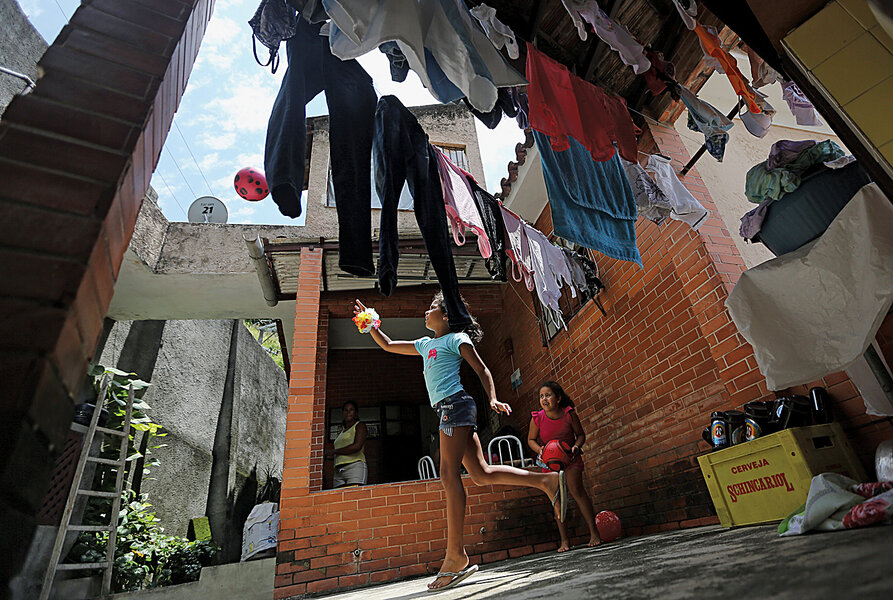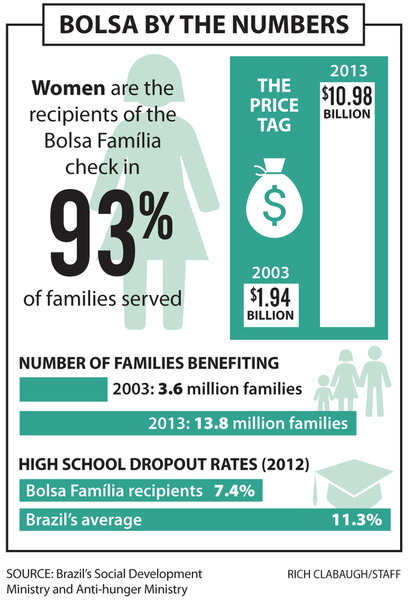Brazil's Bolsa Família: welfare model or menace?
| MARICÁ, Brazil
The streets in this run-down town of 130,000 are nearly empty during work hours. There are few jobs here. But in the wee hours of the morning, bleary-eyed workers pile into buses headed for Rio de Janeiro, about two hours away, or the Petrobras state oil refinery under construction in nearby Itaboraí.
But one office in Maricá is bustling: the government benefits center. About 20 women and children fidget on the worn chairs lined in front of the cramped office where notebooks filled with applications for antipoverty programs are stacked almost to the ceiling.
Many are here applying for the Bolsa Família conditional cash transfer (CCT) program, a landmark poverty reduction effort in Brazil that has helped raise 36 million Brazilians out of extreme poverty and is currently celebrating its 10th anniversary. In Maricá alone, some 6,000 families receive monthly payouts.
The program – which consists of small stipends given preferentially to women and mothers in exchange for children attending school and receiving regular medical checkups in public clinics – has become an international model and, the government says, reached Brazilians once so marginalized they weren't plugged into public health, schooling, or housing services.
"What do we want? To take people out of misery," says Tereza Campello, the minister for social development and food security.
The number of families receiving Bolsa Família payments has grown nearly fourfold since 2003 to include 50 million Brazilians – one-fourth of the country's population – while costing half a percentage point of the nation's gross domestic product.
Policymakers say that's a bargain. But as the Bolsa program continues to grow, so does its body of critics: Brazilians fed up not only with what they see as populist handouts, but in general with high taxes and the way the government applies that revenue. There are also accusations of fraud; the government admits the requirements for new applicants aren't very stringent.
Delegations from dozens of countries, from Vietnam to Jordan to the Bahamas, have studied the program, which was the hemisphere's first CCT. Bolsa began at the municipal level in 1995, and by 2003 went national.
The World Bank says that 1 in 4 Latin Americans is now covered by some version of a CCT developed after Brazil's, such as those in Mexico, Colombia, or Chile.
But in the decade since the welfare program expanded nationally, Brazil has transformed into a more middle-class country, and some say Bolsa has already completed what it set out to do. It's now getting to be too large, critics say, and it has sparked debates similar to ones in the United States over how to best lift the poorest out of misery without becoming a so-called welfare nation.
Foreign governments and academics have watched Bolsa Família's development as it speaks to this age-old debate: Is it the government's role to step in to alleviate poverty? If so, what is the right amount of aid to avoid dependency but still deliver a boost?
"For us, the Bolsa is more than a program for Brazilians.... [It] can help in changing the world," says Hans-Horst Konkolewsky, secretary-general of the Geneva-based International Social Security Association. Mr. Konkolewsky says CCTs like Bolsa Família, which means "the family purse," are long-term approaches to alleviating poverty.
"In line with the international movements to build social protection floors, I think we will see more CCTs established," Konkolewsky says.
Bolsa Família stipends are meant to complement a family's declared earnings in an effort to raise monthly income to about $70 per person for families with children, or $35 for those without. Those amounts are small for a working Brazilian – a middle-class family in pricey Rio easily spends that on a dinner out. The national minimum monthly wage is about $340, and the average Brazilian makes about $900 a month, according to Brazil's census agency.
"This [program] came to stay. Politically it would be impossible to go back," says Tiago Berriel, an economist who has studied Bolsa Família at the Fundação Getúlio Vargas.
Investment vs. expenditure
The changes in Brazil's social indicators over the past 10 years paint a picture of Bolsa's success. Between 2001 and 2011, the infant mortality rate fell 40 percent overall. Its most drastic decline has been in the northeast, traditionally Brazil's poorest area, where it showed a 50 percent drop. The percentage of children who are underweight or unhealthily small has also fallen among families that receive a Bolsa stipend, as has the number of childhood deaths associated with malnutrition.
Still, Bolsa Família has become a favorite target of Brazilians who accuse the program of being a populist vote-buying mechanism.
Public expenditures on the Bolsa program have risen from about $1.94 billion in 2003 to an estimated $10.98 billion in 2013. Ms. Campello estimates that some 600,000 additional families qualify for the program and still need to be included in order to cover Brazil's most impoverished.
A high tax burden and low-quality public services, including education, mean that middle- and upper-class families often feel obligated to pay for private school and health care out of pocket. In Brazil, for example, the average person works 150 days a year to pay taxes, compared with 102 days in the US. Among the 30 countries with the highest tax burdens, Brazil ranks last in terms of the quality of services citizens receive in exchange for high taxes, according to the Brazilian Institute of Tax Planning.
"Bolsa Família already has its second generation of dependents! Grandkids of women in the program are the way daughters make sure they too get the benefit," columnist Augusto Nunes wrote in the weekly Veja, a favorite among Brazil's conservative upper-class citizens. Rather than bringing families out of poverty, Bolsa Família "preserves misery," Mr. Nunes wrote.
An example of a second generation of beneficiaries could be seen outside the Maricá benefits office. Andreza da Silva Ferreira's father retired with no pension after years of informal construction work, and her mother, who completed only second grade before leaving school to take care of her own father, picks up odd jobs as a housecleaner and currently draws on Bolsa Família. Ms. Ferreira worked in elder care before leaving school to have a child, and her husband was killed soon after the boy's birth.
The family's total income is about $250 per month, from housecleaning, odd sales jobs, and Ferreira's mother's $50 Bolsa Família check. Waiting in line, Ferreira says she's applying for her own Bolsa stipend now that she has a son.
"It would be for him," she says.
Campello criticizes what she calls a pre-Bolsa Família mode of thought on social programs, which follows the line of thinking that anything can be given to the poor except cash, because it could be spent on nonessentials.
The poor can be trusted to invest wisely in themselves, Campello says.
"If you spend it to do small repairs on your house? Great. If you spend it on clothes for your child? Great," she says. "When it's a subsidy for the wealthy, it's called investment. When it's for the poor, it's called an expenditure," she says.
Corruption?
The staying power of Bolsa Família is a dispute like ones in other countries, most notably the US, where in the late 1970s terms like "welfare queen" were coined to describe recipients purportedly abusing the system. In Britain, Conservative politicians have derided a "something for nothing" attitude they see in welfare recipients.
Applicants for the program here report their income, and the government does not rigorously check their claims. Rather, it prioritizes getting more families into the program over examining the claims of each beneficiary. It can be easy to game the system, critics say. Cases of fraud have dinged the program's image.
A recent media report created an uproar after it showed more than 2,000 politicians elected in 2012 received Bolsa payments, even after being elected. Among the fraudulent recipients were mayors and city councilmen.
Yet there is little evidence that the small stipend encourages Brazilians to stop working. Campello says 75 percent of adults who receive the payments are economically active, either looking for work or employed, though often in informal jobs that come without pensions and sick leave. "The people who leave [their jobs] for Bolsa Família are people whom we call ineffective labor. Their productivity was already very low," says economist Mr. Berriel.
Inequality
But no matter how effective proponents find the Bolsa program to be, it can't change more intractable issues like income inequality and low-quality education on its own.
The income of the poorest Brazilians is still not rising on par with that of the wealthiest, underscoring that poverty reduction does not necessarily equal inequality reduction. Between 2002 and 2012, income rose 2.5 percent for the poorest 20 percent of Brazilians – the lowest growth for all income groups – while it rose 6.4 percent for the top 20 percent income earners in the country.
And while better school attendance statistics paint a favorable picture of Bolsa, skeptics say the low quality of public schools punctures the optimistic view those numbers convey.
The government says 95 percent of school-age kids from families receiving Bolsa stipends fulfill their school requirements. While the percentage of students who drop out of high school nationally is 11.3, it is only 7.4 for students whose families are Bolsa Família recipients.
But public schools have a series of needs, from better teacher salaries to better infrastructure. A recent study from the universities of Brasília and Santa Catarina found that fewer than 1 percent of Brazilian public schools have optimal facilities, including libraries, computer access, and sports areas. A public education here doesn't necessarily ensure a high-quality education or social mobility, Berriel says.
The positive Bolsa school statistics "don't mean our formation of human capital is very good," he says. The portion of its GDP that Brazil spends on education is comparable to that of other countries, nearly 6 percent, but Brazil gets a low return on that investment. Brazilian 15-year-olds test significantly lower than the Organization for Economic Cooperation and Development average, scoring 412 and 386 on reading and math respectively, compared with 493 and 496 on average in OECD countries. Those scores put Brazil on par with countries like Tunisia and Romania.
"We are not buying a lowering of inequality," Berriel says.
Luana Menezes de Noronha, an administrator of Bolsa Família in Maricá, says the program has made strides in reducing poverty. But she's concerned that recipients have not internalized the values of the program and are still focused on the day-to-day needs that the cash transfers alleviate. She describes families who complain that the health and education requirements of the program are a "penalty." "I'm concerned that sometimes the user doesn't understand the program," she says. "Vulnerability and poverty are not just issues of not having money."







